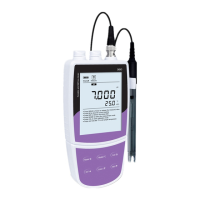Electrode Maintenance
Cleaning the pH Electrode
Since pH electrode is susceptible to contamination, thoroughly clean
as necessary after each use.
• General Cleaning
Rinse the pH electrode with distilled water and soak in 3M KCl
solution.
• Salt Deposits
Dissolve the deposit by immersing the electrode in warm tap
water. Rinse the electrode with distilled water and soak in 3M
KCl solution.
• Oil or Grease
Place the electrode in the detergent or ethanol solution for 15
minutes. Rinse the electrode with distilled water and soak in 3M
KCl solution.
• Protein
(1) Add 1% pepsin to 0.1M HCl solution.
(2) Place the electrode in above solution for 15 minutes.
(3) Rinse the electrode with distilled water and soak in 3M KCl
solution.
• Clogged Liquid Junction
(1) Heat a diluted KCl solution to 60° C (140° F).
(2) Place the electrode into the heated solution for 10 minutes.
(3) Allow the electrode to cool in unheated KCl solution.
Reactivating the pH Electrode
If the pH-sensitive membrane has dried out, the electrode response
will become sluggish. Immerse the electrode in a pH 4.01 buffer
solution for about 30 minutes to rehydrate. If this fails, the electrode
requires activation.
1. Soak the electrode in a 0.1M of HCl for 10 minutes.
2. Remove and rinse with distilled water, then place into a 0.1M of
NaOH for 10 minutes.
3. Remove and rinse again, and soak in 3M KCl solution for at least
6 hours.
If these steps fail to restore the response, replace the electrode.
Storing the pH Electrode
• For best results, always soak the electrode in 3M KCl solution.
• If above solution is not available, use a pH 4.01 buffer solution.
• DO NOT store the electrode in distilled or deionized water that
will deplete the hydration layer of the pH-sensitive membrane
and render the electrode useless.
• If you do not use the electrode for a period longer than 1 month,
store the electrode in storage solution.

